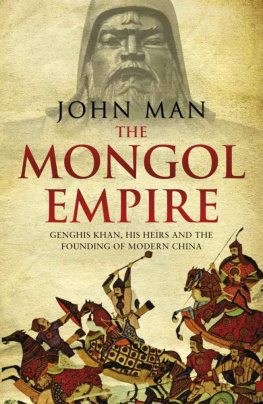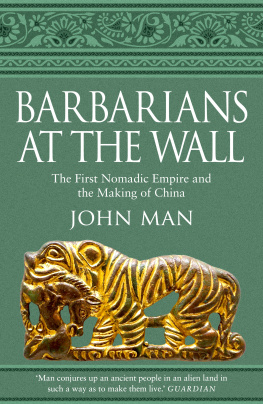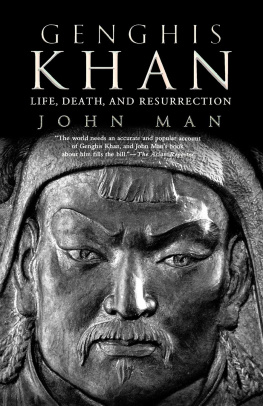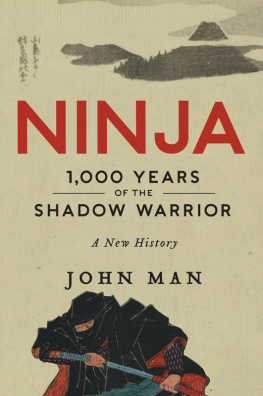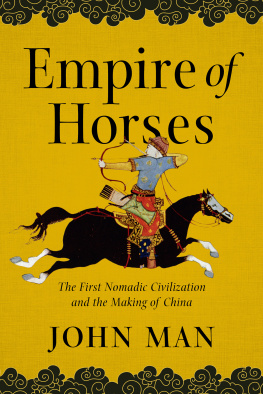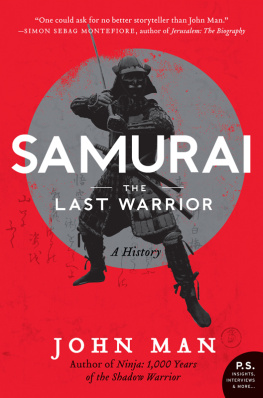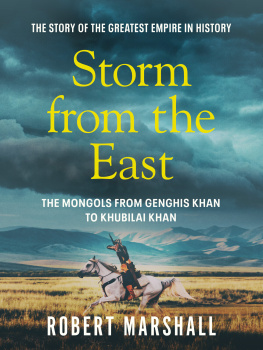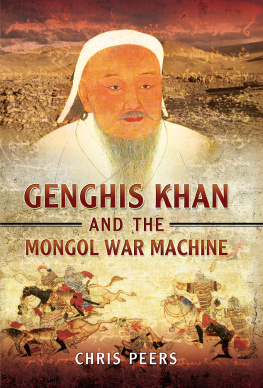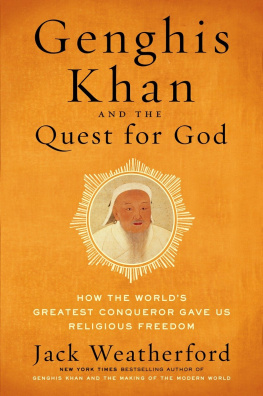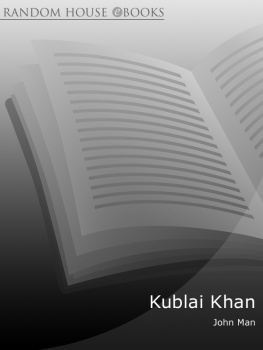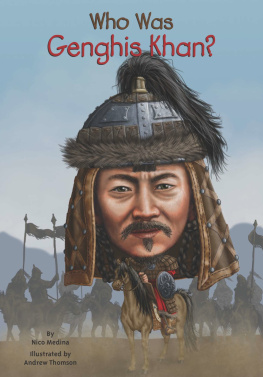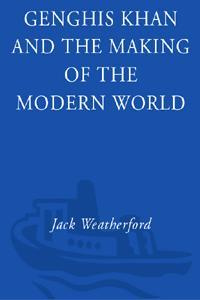ABOUT THE BOOK
The Mongol Empire changed the course of history and transformed the map of the world. Driven by an inspiring vision for peaceful world rule, Genghis Khan mass-murdering barbarian to his victims, genuis and demi-god to his people united warring clans and forged an empire that spanned Asia, bringing people, cultures and religions together and opening intercontinental trade.
Under his grandson, Kublai Khan, the vision evolved into a more complex ideology, justifying further expansion. Fuelled by the belief that Heaven had given the whole world to the Mongols, Kublai doubled the empires size until, in the late thirteenth century, he and his family controlled one-sixth of the worlds land area. Along the way, he conquered China, made Beijing his capital and gave the nation the borders it has today, establishing the roots of the twenty-first century superpower.
Charting the rise and eventual fall of Genghiss Golden Family, John Mans authoritative account brings the empire vividly to life, providing essential reading for anyone with an interest in history, geopolitics, and todays complex and volatile world.
CONTENTS
THE MONGOL EMPIRE
Genghis Khan, His Heirs and the Founding of Modern China
JOHN MAN
For TW and DW-M
MAPS
ACKNOWLEDGEMENTS
With thanks to: Chris Atwood, Professor of Mongolian History, Indiana University; Charles Bawden, Emeritus Professor, and former Professor of Mongolian at the School of Oriental and African Studies, London, who started it all; Dr Dambyn Bazargur and Badraa; Siqin Brown, SOAS; Yuefan Deng, Stonybrook University, NY; Dalai, historian, Ulaanbaatar; Ruth Dunnell, Associate Professor of Asian History and Director of International Studies, Kenyon College, Gambier, Ohio; Erdenebaatar, Institute of Animal Husbandry, Ulaanbaatar; Stephen Haw, for vital guidance on Marco Polos China; Helen, Renmin University, Beijing, for wonderful interpreting; Professor Tsogt-Ochir Ishdorj, Head, Department of Historiography, History Institute, Mongolian Academy of Science; Jorigt and Nasanbayar of the Mongolian Language Institute, School of Mongolian Studies, Inner Mongolia University, Hohhot; Luc Kwanten and Lilly Chen, Big Apple-Tuttle Mori, Beijing and Shanghai; Professor Yao Dali, History Department, Fudan University, Shanghai; Lars Laaman, History Department, SOAS, for his help with Sharaldai (see ) and his translator, Geok Hoon Williams; Yuan-chu Ruby Lam, Department of Chinese, Wellesley College, MA; Du Jian Lu, Xi Xia Institute, Ningxia University; Richard John Lynn, for his Xanadu verse translations; Tom Man, of Perioli-Man, Oxford, for putting flesh on the Pleasure Dome; David Morgan, formerly Professor of History, University of Wisconsin-Madison; Nachug, Director, Institute for Genghis Khan Studies, Edsen Khoroo (Genghis Khan Mausoleum); Oyun Sanjaasuren, MP, leader of Citizens Will-Republican Party, Head of Zorig Foundation; Igor de Rachewiltz, School of Pacific and Asian Studies, Australian National University, for vital and unstinting guidance; Panoramic Journeys, together with Esee, two Nyamas, Ravi, Refika, Nancy and Joan; my Mongol guides, Goyotsetseg Reston (Goyo) and Tumen; Randall Sasaki, Texas A&M University, and Kenzo Hayashida for an introduction to Kublais lost fleet; Sainjirgal, researcher, Genghis Khan Mausoleum; Sharaldai, theologian, Genghis Khan Mausoleum; Professor Noriyuki Shiraishi, Niigata University, for his comments and guidance in Avraga; Professor Chris Tyler-Smith, formerly at the Department of Biochemistry, Oxford University, for his help on Genghiss genetic legacy; Professor Wei Jian, Renmin University, Beijing, for unique insights and inspirational guidance; William Shou for the Xanadu trip; Jack Weatherford, Macalester College, MN; Graham Taylor, Karakorum Expeditions, Ulaanbaatar; Frances Wood, British Library; Lijia Zhang, Beijing, for friendship; as always, Felicity Bryan and her team; and in Transworld Doug Young, Henry Vines and Sheila Lee.
The quotations from The Secret History are from de Rachewiltzs version (see ), with permission from Koninklijke Brill NV, Leiden, Netherlands.
A note on spelling
In transliterating Chinese, pinyin is now standard, but it still overlaps the old WadeGiles system. I use whichever seems more appropriate. Spellings of personal names vary widely. Genghis is pronounced Chingis in Mongol, and should really be spelled like that in English (to overcome a common fault: the G is soft, as in George, not hard, as in good). I retain Genghis out of deference to tradition. I use the more familiar Kublai rather than Khubilai, Qubilai or Kubla. Xanadu is Shangdu (Upper Capital) in Chinese; but Xanadu is traditional in English, thanks to Coleridge.
INTRODUCTION
THE IDEA FOR this book came from working on a proposal for a series of films. I was in Hohhot, Inner Mongolia, with a corporate boss who was interested in promoting Mongol culture. One of his ambitions was to commission a feature film to tell the story of Genghis Khan. It would be big budget, $100 million in Hollywood terms, appealing to audiences worldwide. Never mind other films on the same subject no one had done Genghiss whole life. He had already discussed the project with three Hollywood scriptwriters. Things had not gone well. I could see why. He was interested in history, but knew little about narrative techniques; Hollywood scriptwriters know a lot about narrative, but care little about history. I saw one script by a well-known writer. It had this body-copy in an opening scene:
The desert giving way to grass sparse and flat. A woman, solitary, a symbol of sensuous feminine grace, carries water balanced on her head. Her hips sway timelessly.
It would never work, not just because in Mongolia no woman ever carried water on her head, let alone doing so while symbolizing grace with hips swaying timelessly. It would not work because of the history. Genghiss story is too big to be contained in a single film, even for a brilliant scriptwriter willing to become familiar with medieval Mongolia, China, Korea, Tibet, Japan, Russia, Georgia, Hungary, shamanism, Islam, Buddhism and Daoism. You could no more compress it into a hundred or so minutes than you could the Second World War.
Its not just the range of material that makes it impossible. It wouldnt work because Genghiss empire is only part of the story. He died halfway through. His grandson Kublai took up where Genghis left off, doubling the empires size over the next seventy years. A single book, possibly; a single film, no.
So, I told him, he would have to think really big. How about not one film, but nine? How about not $100 million, but $1 billion? That would give scope to tell the full story.
He loved the idea. The problem is it will never happen, not because of the history, which divides quite neatly into nine self-contained stories, but because of its scope. How on earth do you write nine films all at once and they have to be all written together, because they interrelate let alone shoot them?
The discussion had a positive outcome. It made me take the long view and look back on the Mongol empire from today, with Asia dominated by the empires top successor-state, China.
On the map, China is, as its name says, zhong guo, or Central Nation, a singularity, a unity, linking the Pacific to Central Asia, the gravelly wastes of the Gobi to subtropical Hong Kong. But the view from inner space suggests otherwise. Open Google Earth, find China, drift from west to east for 4,000-plus kilometres, and you will see that ecologically the nation is divided. The west and north are all browns and greys, marking the deserts of Xinjiang, the icebound wrinkles of the Tibetan plateau and the grasslands of Mongolia. There are few picture-icons on screen. Click on some and you will see why huge skies, lunar landscapes, unnamed mountains, hardly a city and not many people.

